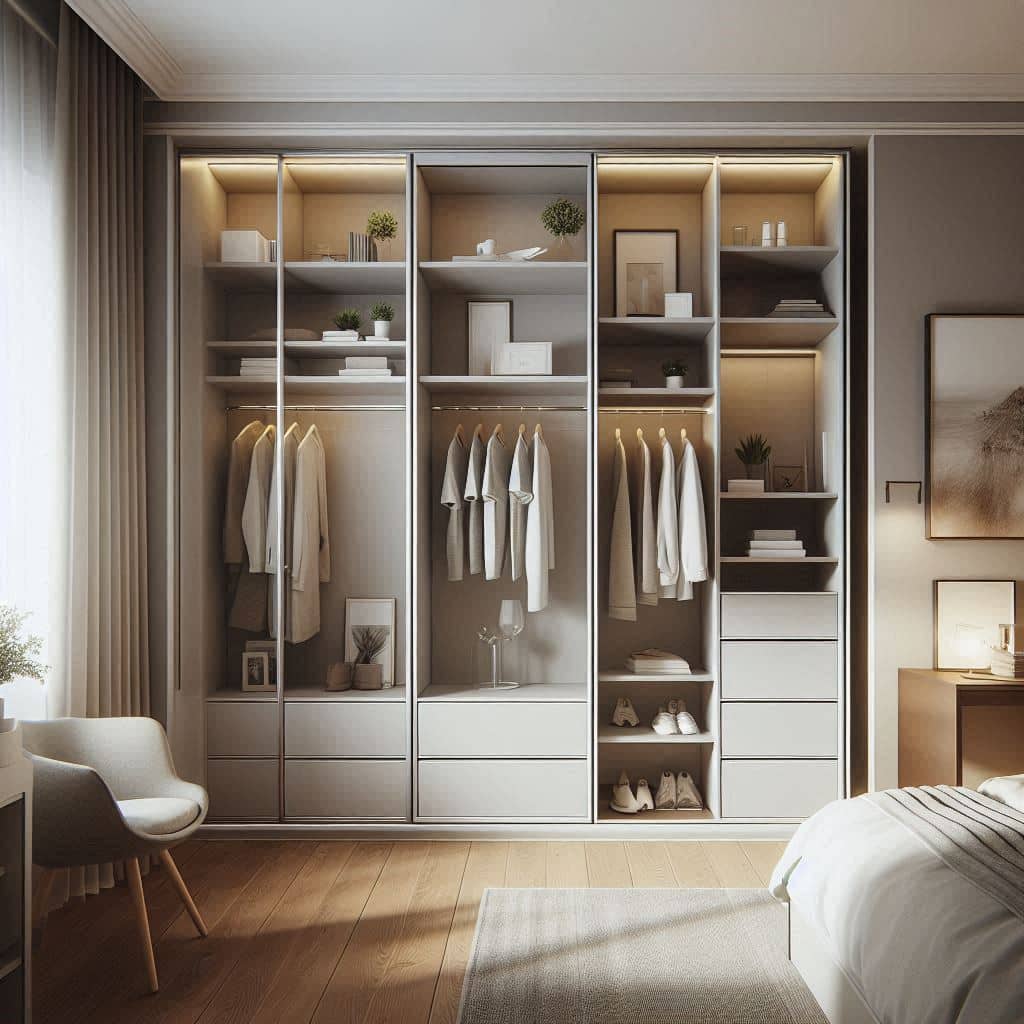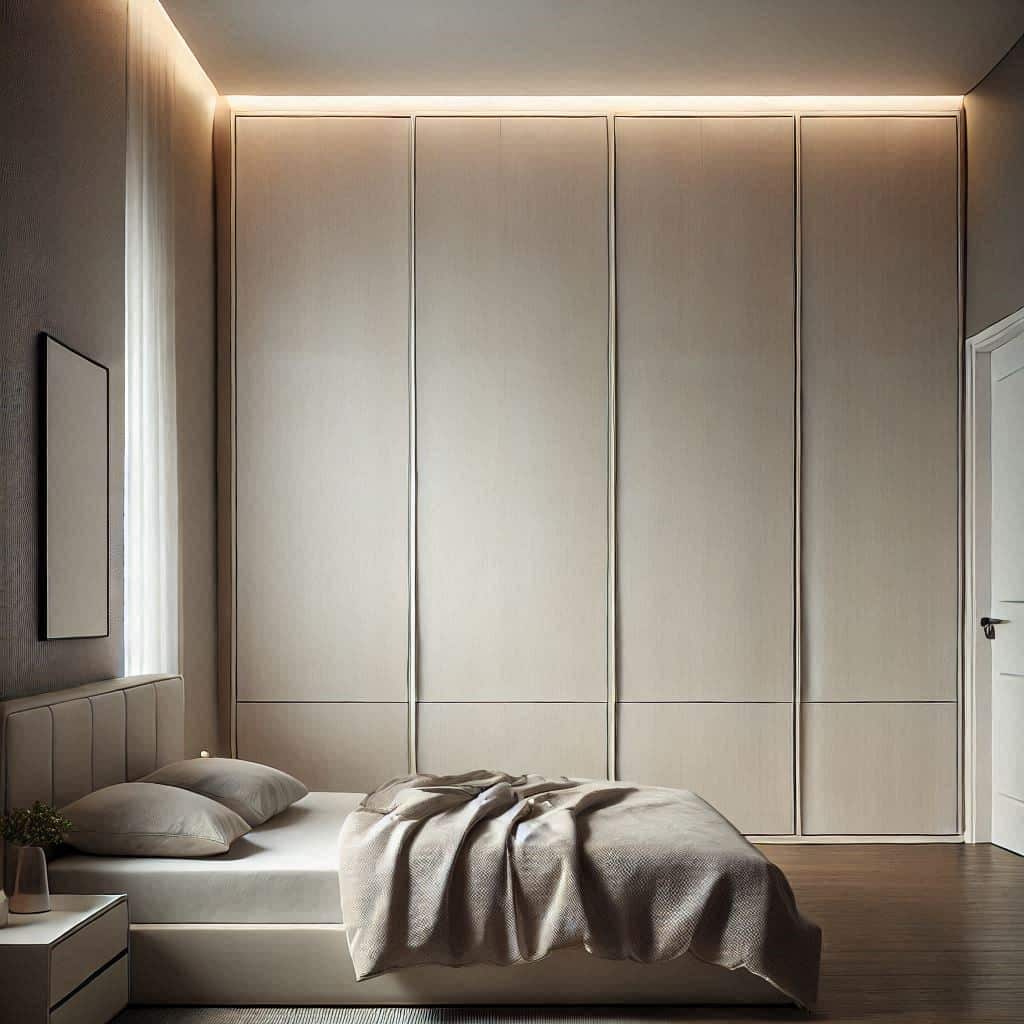In today’s modern homes, maximizing space is more important than ever. With the rise of minimalistic interiors and the demand for smarter storage solutions, built-in wardrobes have become the go-to choice. Not only do they offer a sleek, customized look, but they also serve as one of the most effective ways to save space in your home. Let’s dive into the top five reasons why built-in wardrobes are the ultimate space savers.
Custom-Fit Built-In Wardrobes for Space Maximization

Built-in wardrobes offer the ultimate flexibility in utilizing every inch of space. Whether you’re working with a small bedroom, an attic room, or a space with slanted ceilings, these wardrobes are tailored to fit the exact measurements of your room. Unlike freestanding wardrobes that often leave awkward gaps, built-in wardrobes maximize storage and seamlessly integrate with the rest of your home.
For example, a customized wardrobe built into an alcove can hold everything from clothes to books and shoes, leaving your room free of clutter. And by designing up to the ceiling, you prevent wasted overhead space, ensuring that no square inch is left underutilized.
Practical tip: Consider using modular designs within the built-in wardrobe. These systems allow you to adjust shelves, drawers, and hanging rods based on your storage needs, providing extra flexibility for future changes in your wardrobe.
Why Built-In Wardrobes Save Space in Small Bedrooms
In a small bedroom, space is precious. Built-in wardrobes help you reclaim valuable floor space by fitting perfectly into nooks, corners, or even along the walls, making your room feel larger. With the option to customize the depth and width, you can create a storage solution that doesn’t overpower the room.
A sliding door system is particularly effective in tight spaces since it doesn’t require extra clearance for opening. This is especially important if you have a narrow bedroom or limited floor space. In contrast, traditional hinged doors demand more room to swing open, which can make a small bedroom feel cramped.
Real-life example: A client in a 10×10 bedroom installed a sliding-door built-in wardrobe along the wall, incorporating adjustable shelves and hidden compartments. This not only saved floor space but also added a clean, minimalist look to the room.
How Built-In Wardrobes Fit Oddly Shaped Spaces
Every home has those difficult corners or unusual alcoves that seem impossible to make functional. Built-in wardrobes are the perfect solution for these oddly shaped spaces. Whether it’s a staircase void, a slanted attic ceiling, or a small alcove by the window, a built-in wardrobe can be designed to match the space, making it look purposeful instead of awkward.
For example, under-stairs storage can be transformed into an elegant, custom wardrobe. By designing shallow, slanted shelving units with pull-out drawers, you can turn this underused space into a highly functional storage area.
Pro Tip: When designing for odd spaces, it’s important to use flexible materials that can be easily shaped or adapted. For instance, bamboo or plywood are both sturdy and versatile options for irregularly shaped areas.
Choosing Materials and Finishes for Built-In Wardrobes
The materials and finishes you choose for your built-in wardrobe will impact both its functionality and aesthetics. Lighter finishes, such as white lacquer or light oak veneer, work well in smaller rooms by reflecting light and making the space feel open and airy.
For more luxurious designs, consider using walnut or dark-stained wood. These rich materials create a dramatic effect, especially in larger rooms, without making the space feel too heavy. If you prefer a modern minimalist aesthetic, matte black or neutral-tone panels can seamlessly blend with your room’s décor.
Real-life example: A homeowner used white oak with a matte finish for their built-in wardrobe in a small coastal bedroom. The light finish reflected the natural light coming through the windows, enhancing the airy feel of the room.
Built-In Wardrobe Designs for Eliminating Wasted Space
The beauty of built-in wardrobes is their ability to use every corner of a room. For instance, a built-in wardrobe can be designed to fit around windows, under eaves, or even along awkward walls that don’t fit conventional furniture. When properly designed, built-ins can completely eliminate wasted space, turning areas that would otherwise remain empty into functional storage zones.
For example, consider adding adjustable hooks inside the wardrobe to store accessories or scarves that would otherwise take up drawer space. You can even design built-in drawers underneath your wardrobe to store shoes or bags, making every inch count.
Transforming Wasted Space into Practical Storage
Dead spaces in your home—such as corners, alcoves, or areas underneath stairs—can be transformed into highly functional storage with built-in wardrobes. A tailor-made wardrobe can be created to fit into these spaces, ensuring that no area of your home is left unused.
For example, under-stairs storage is often overlooked, but with the right design, it can hold everything from shoes to cleaning supplies or books. Adding custom shelving or drawers ensures that these spaces remain organized and clutter-free.
Pro Tip: If you have an alcove that’s too small for furniture, use floor-to-ceiling wardrobes to create extra storage while keeping the area open and visually balanced.
Under-Stairs Storage Solutions with Built-In Wardrobes
The area under stairs is often one of the most underutilized spaces in a home. By installing a built-in wardrobe in this area, you can create a compact and efficient storage solution. Instead of leaving this space cluttered, a built-in wardrobe can hold seasonal items, shoes, cleaning products, or even coats.
Consider creating multiple levels of shelving or pull-out drawers in these built-in designs to maximize vertical space, making it perfect for storing smaller items.
Sliding or Hinged Doors: Maximizing Space in Built-In Wardrobes
When choosing between sliding or hinged doors for your built-in wardrobe, it’s essential to consider the size and layout of your room. Sliding doors are ideal for narrow or cramped spaces since they don’t require extra clearance. Hinged doors, on the other hand, are better suited for larger rooms where you have the space for the door to swing open.
Pro Tip: If you’re working with a narrow hallway or small room, opt for mirrored sliding doors. Not only do they help maximize storage, but they also make the room feel brighter and more spacious.
Organizing Your Life with Built-In Wardrobes for Maximum Efficiency

A well-organized wardrobe can transform your daily routine, and built-in wardrobes make this process seamless by offering tailored storage solutions for your clothes, accessories, and more. Adjustable shelves, hanging rods, and integrated drawers allow you to create a space that caters specifically to your needs, whether you want to organize clothes by season, type, or frequency of use.
Example: You can install tiered shelves for folded clothes, pull-out racks for ties or scarves, and built-in drawers for accessories like belts and jewelry. Dividers within drawers help you keep smaller items such as socks, gloves, or jewelry neatly organized and easy to find.
Pro Tip: Install double-hanging rods for shorter clothing like shirts and pants. This setup maximizes vertical space while keeping your clothes wrinkle-free and easily accessible.
Essential Accessories to Enhance Built-In Wardrobe Organization
While built-in wardrobes provide excellent storage options, the right accessories can take their organization and functionality to the next level. Accessories like pull-out shoe racks, built-in jewelry trays, tie racks, and drawer dividers let you store items in an organized and efficient manner.
Example: Pull-out shoe racks are a fantastic way to store shoes without wasting precious shelf space. These racks allow you to display your shoes in an organized, visible manner, making it easier to choose your pair each morning. Built-in jewelry trays can be customized to your preferences, providing dedicated spaces for necklaces, bracelets, and rings, preventing tangles, and ensuring you find what you need quickly.
Real-life Example: A homeowner added pull-out baskets for scarves and gloves, neatly storing these smaller accessories at the bottom of their built-in wardrobe. This not only saved space but also kept the items from getting lost or crumpled.
How Built-In Wardrobes Reduce Clutter and Organize Your Space
Built-in wardrobes play a crucial role in reducing clutter by providing designated spaces for each item, from clothes to shoes and accessories. With a dedicated place for everything, you can avoid the chaos that often accompanies overcrowded rooms.
Example: A built-in wardrobe with customizable drawers lets you store smaller items like bags, belts, or hats, keeping them organized and out of sight. Adjustable shelves allow you to fit shoes, folded clothes, or storage baskets for less frequently used items.
Pro Tip: Use labeled baskets or bins for items that are harder to organize. This will keep your wardrobe looking tidy and prevent clutter from building up.
Built-In Wardrobes vs. Freestanding Closets: Space Efficiency Compared

Space-Saving Benefits of Built-In Wardrobes Over Freestanding Closets
When comparing built-in wardrobes to freestanding closets, the built-in option clearly outperforms in space optimization and functionality. Built-ins provide more design flexibility and use the available space more efficiently.
Unlike freestanding closets that take up extra floor area and may leave awkward gaps, built-in wardrobes are customized to fit the exact measurements of your room. They eliminate the need for bulky furniture and optimize even the trickiest corners or alcoves.
Example: You can install a built-in wardrobe along an entire wall, from floor to ceiling, making the most of unused vertical space. In contrast, a freestanding closet might only offer limited vertical storage, leaving empty spaces above. With a built-in, every inch of space is used efficiently, including corner shelving and hidden compartments in underutilized areas.
In smaller spaces, built-in wardrobes also offer a smart choice. They can be customized with sliding doors, perfect for narrow rooms, while traditional closets often require space for swinging doors, consuming valuable floor space.
Cost-Effective Built-In Wardrobes vs. Freestanding Closets
The initial cost of a built-in wardrobe might be higher than a freestanding closet, but its long-term benefits far outweigh the upfront expenses. Built-in wardrobes are customized to your space, offering exactly the storage and functionality you need. This optimization reduces the need for extra storage furniture, saving you money and maximizing your space.
Built-in wardrobes are also more durable, adding long-term value to your home. They can improve your home’s resale value, making them a smart investment, especially if you plan to sell in the future. In contrast, freestanding closets often fail to increase your home’s market value since they aren’t integrated into the space and are viewed as temporary solutions.
Real-life Example: Homeowners who installed built-in wardrobes found they could eliminate the clutter of multiple standalone units. This not only saved money by cutting out the need for extra dressers, shoe racks, or shelves but also gave their rooms a more organized and cohesive feel—something that could significantly increase their home’s appeal to potential buyers or renters.
Maximizing Room Space with Built-In Wardrobes Compared to Freestanding Closets
Built-in wardrobes maximize room space more effectively than freestanding closets. They are tailored to fit the unique dimensions of your room, from walls to corners and even areas under stairs or sloped ceilings. This ensures you use every available inch, creating custom storage solutions that meet your needs.
For example, built-in wardrobes can easily fit under angled ceilings in attics or along narrow hallways—spaces where freestanding units are impractical or impossible to place. They also integrate seamlessly into other parts of the home, like the entrance foyer, providing storage without disrupting the flow of the room.
Freestanding closets, however, often force you to compromise on layout. You may need to place them in a corner or against a wall, meaning you’re not using the room’s full potential. They also typically require extra space around them for access, which can clutter the room.
Real-life Example: In a compact apartment, a homeowner installed a built-in wardrobe along an entire bedroom wall. This transformed the previously wasted space into a functional and stylish storage solution. The wardrobe fit flush with the wall, ensuring it didn’t intrude into the room, unlike a freestanding unit that would have taken up valuable floor space.
Conclusion
Built-in wardrobes are undoubtedly the ultimate space savers. With their customizable design, ability to eliminate wasted space, and potential to enhance the aesthetic of any room, they offer a perfect blend of style and practicality. Whether you’re looking to maximize storage in a small bedroom or organize your entire wardrobe, a built-in solution will not only save space but also add a sophisticated touch to your home.
FAQ
- How do custom-built wardrobes save space in small rooms? Custom-built wardrobes are tailored to fit small spaces, with features like sliding doors to maximize storage.
- Can built-in wardrobes fit odd-shaped spaces? Yes, built-in wardrobes can be designed to fit awkward spaces like under stairs or in attic rooms.
- How do built-in wardrobes match room décor? Built-in wardrobes offer a sleek, customizable design that blends seamlessly with your home’s style.
- How can I organize my built-in wardrobe? Add accessories like shoe racks, jewelry trays, and adjustable shelves for maximum organization.
- How are built-in wardrobes better than freestanding closets? Built-in wardrobes save more space by fitting into walls, offering a streamlined look and better functionality.
People Also Read:
Interior Mobile Home Doors: Step-by-Step Guide to Replace Them
